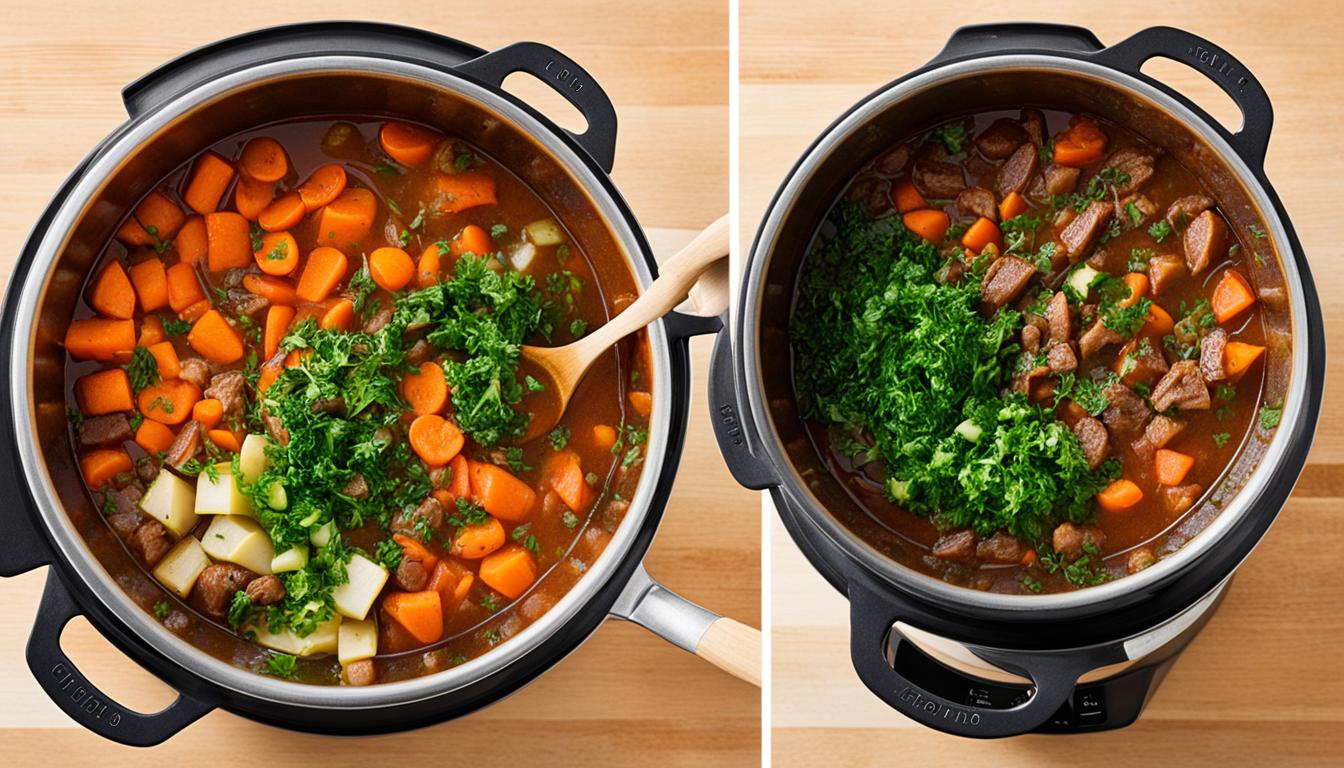Have you ever wondered if stew gets better with age? Does it truly reach its peak flavor and texture after hours of simmering? We’re about to uncover the fascinating science of stew aging and explore the process behind its flavor development over time. Prepare to challenge your beliefs and discover the benefits of aging stew.
As food enthusiasts, we’ve all heard the saying, “Stew always tastes better the next day.” But is there any truth to this statement? Is there a scientific explanation for the improvement in flavor and texture? Let’s unravel the mysteries and delve into the factors that contribute to the enhancement of flavors over time.
But before we begin, let’s take a moment to visualize the mouthwatering delight of a perfectly aged stew. Imagine tender pieces of meat, infused with rich flavors, and a harmony of herbs and spices that create a symphony of taste. Picture the vegetables, soft and succulent, soaked in a flavorful broth that has been slowly developing over hours of cooking. Now, let’s explore the stew aging process to understand how all of this magic happens.
The Role of Slow Cooking in Stew Aging
Slow cooking plays a vital role in the process of stew aging. When we cook stew at a low temperature for an extended period, the flavors have the opportunity to develop and intensify. This slow cooking process allows the ingredients to break down gradually, releasing their flavors and creating a rich and savory stew.
There are various techniques that can be employed to enhance the aging process of stew. One method is to marinate the ingredients before cooking, which helps to infuse them with additional flavors. Another technique is to add herbs and spices throughout the cooking time to further enhance the taste. These methods contribute to the overall complexity and well-roundedness of the stew.
Studies and experiments have been conducted to explore the impact of slow cooking on stew aging. Researchers have observed that slow-cooked stews tend to have a more pronounced and well-developed taste compared to stews prepared with a shorter cooking time. The slow cooking process allows for the flavors to meld together, resulting in a more satisfying and flavorful dish.
The Impact of Wine in Stew Aging
Wine plays a crucial role in the aging process of stew, contributing to the development of flavors over time. The acidity, fruitiness, and tannins in wine work together to enhance the stew’s taste as it matures.
When wine is added to stewed ingredients, it helps to tenderize the meat, infuse it with rich flavors, and add depth to the overall taste. The flavors of the wine gradually meld with the other ingredients, creating a harmonious and complex flavor profile that evolves over time.
The interaction between the wine and the stew’s ingredients is a key factor in enhancing the overall flavor through the aging process. As the stew ages, the wine’s unique characteristics become more pronounced, resulting in a deeper, more enjoyable culinary experience.
As a result of this interplay between the wine and the stew ingredients, the flavors continue to develop and evolve over time, enhancing the overall taste of the dish. The longer the stew ages, the more the wine’s attributes become integrated and balanced, adding complexity to every bite.
Whether you choose a robust red wine for a meaty stew or a delicate white wine for a lighter dish, incorporating wine into the stew aging process will elevate the flavors and create a memorable dining experience.
The Benefits of Aging Stew
There are several benefits to aging stew. Firstly, the flavors of the stew become more pronounced and meld together, creating a more well-rounded and delicious dish. As the stew ages, the individual flavors of the ingredients have time to develop and blend, resulting in a harmonious taste that is greater than the sum of its parts.
Not only do the flavors improve, but the textures of the stew also undergo a transformation. The meat becomes tender and succulent, as it slowly breaks down during the aging process. This results in a melt-in-your-mouth experience that can only be achieved through proper aging. Likewise, the vegetables in the stew soften and absorb the rich flavors, adding depth and complexity to each bite.
Another advantage of aging stew is the better distribution of flavors. As the stew sits, the ingredients have more time to blend and infuse, resulting in a more cohesive and satisfying eating experience. Each spoonful becomes a symphony of flavors that dance on your palate.
However, it is essential to note that stew should not be aged indefinitely. While aging enhances the flavors and textures, there is a limit to how long it can be aged before the flavors start to deteriorate. To ensure the best results, it is important to follow proper storage and food safety practices when aging stew or any other food. This will help maintain the quality and safety of the dish, allowing you to enjoy the benefits of aging stew to the fullest.
